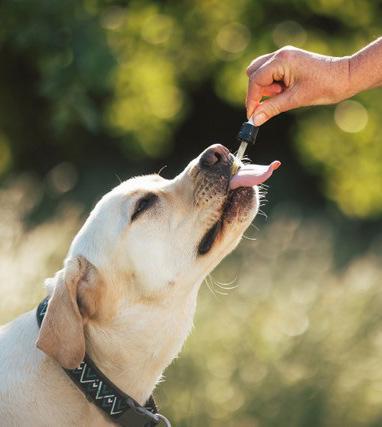
5 minute read
Perspectives from a Veterinary Oncologist on the Use of Cannabis in the Small Animal Oncologic Patient
[THC]) cannabis contains less than or equal to 0.3% THC and may be purchased legally over the counter from retail outlets and the online marketplace.
2. High THC Cannabis
High THC cannabis (also known by the more familiar name of marijuana) contains more than 0.3% THC and is found in cannabis dispensaries.
By Trina Hazzah, DVM, DACVIM (Oncology), CVCH
Veterinarians are being inundated by questions from pet parents regarding the use of cannabis for many of their pets’ conditions, including cancer. Pet owners can purchase hemp products online and at local pet stores, and for those living in states with medical or recreational cannabis laws, high THC products are available in cannabis dispensaries. Widespread accessibility of cannabis products and the owner’s interest in utilizing cannabis for their pets provides veterinarians a unique opportunity to guide pet owners toward safe products.
It is imperative that clinicians understand that cannabis is divided into two varieties based solely on the plant’s legal classification:
1. Industrial Hemp
Industrial hemp (also known as hemp or low delta 9 tetrahydrocannabinol
Cannabidiol (CBD) and THC are just two of over 150 cannabinoids found in the cannabis plant. Cannabinoids are chemical compounds/ligands that bind to specific receptors throughout the body. These receptors are involved in critical functions like mood, appetite, pain signaling, immune health, disease development, and more.
An important point for clinicians to remember is that cannabinoids are molecularly identical, regardless of the plant variety from which they are derived. Both hemp and marijuanaderived products are safe and effective for certain conditions, provided they are dosed appropriately.
Cannabis and Cancer Facts Supported by Current Scientific Evidence
1. Based on in vitro and preclinical studies as well as human clinical trials, complex cannabis products that contain multiple compounds have superior anti-cancer effects compared to pure isolate products.
2. To date, 100+ scientific studies are published on the anticancer effects of various cannabinoids in laboratory animals, with most involving CBD and THC. Results from these studies suggest cannabinoids elicit anticancer effects at several levels, such as inhibiting tumor proliferation, invasion and metastasis, immune modulation, and induction of cancer cell death. Additional evidence suggests that cannabinoids may enhance the effect of conventional treatments like chemotherapy, targeted therapy, and radiation (Hinz 2019, Hermanson 2011, Tomko 2020).
3. Interestingly, the phytochemicals responsible for the aroma (terpenes) and the color (flavonoids) of the cannabis plant have demonstrated direct anticancer activity on their own and may also work additively or synergistically with cannabinoids.
4. Despite studies supporting the hypothesis that cannabinoids may enhance the immune response against progressive growth and spread of tumors, there are some older reports that found drastically different results. These studies found cannabinoids have immunosuppressive action via activation of cannabinoid receptor 2 (CB2), as well as causing upregulation of the regulatory T cells (Tregs), both of which lead to the inhibition of normal (antitumor) immune response. This has not been confirmed in any clinical trials (Hinz 2022).
5. Researchers have not published any clinical trial data evaluating the use of cannabis in tumor-bearing dogs or cats.
6. There are less than a handful of published canine cell culture studies evaluating the antitumor effect of CBD. The results of those studies indicated that CBD had antitumor effects in all of the cell lines, including lymphoma, mammary carcinoma, osteosarcoma, glioma, and transitional cell carcinoma. The studies also noted that, when CBD was used in combination with certain chemotherapy agents, cancer cell death increased (Gross 2021, Henry 2021, and Inkol 2021).

7. There is mixed data regarding a drug-herb interaction between cannabis and immunotherapy. Some studies demonstrated reduced response rates and survival times with the combination, while a recent article showed no negative interaction exists (Taha 2019, BarSela 2020, Waissengrin 2023).
8. Despite cannabinoids demonstrating antitumor activity in multiple cell lines, rodent cancer models, and a small number of human clinical trials, insufficient data exists to determine which combination of compounds or doses is required to kill cancer in dogs or cats.
Cannabis and Palliative Care
Cannabinoid therapeutics have a role in end-of-life care that has been acknowledged through medical cannabis programs for adults globally. Based on my years of clinical experience, several anecdotal veterinary reports, and human published studies, cannabis can absolutely play a role in relieving side effects secondary to cancer or conventional therapy, such as nausea, pain, anxiety, and poor appetite. However, further studies are needed to determine optimal dosing in pets with cancer.
Conclusion
Cannabinoids, terpenes, and flavonoids have all been shown to have antitumor activity in cancer cell lines as well as in animal xenograft models. Cannabinoids may play an integral role in treating pets with cancer. Incorporating cannabis products (both high and low THC varieties) may provide antitumor activity on its own or in combination with conventional therapy. It may also provide palliative support and improve the quality of life of our patients
Dr. Trina Hazzah is a board-certified veterinary oncologist with an additional certification in Traditional Chinese Veterinary Herbal Medicine. She developed an interest in cannabis medicine while searching for integrative approaches for veterinary cancer patients. Over the past eight years, she has treated hundreds of patients with cannabis. Dr. Hazzah is the president and co-founder of the Veterinary Cannabis Society, which is the first US-based non-profit, 501(c)(3) organization building awareness of cannabis as medicine for pets. After almost 15 years of practicing medical oncology, she switched her focus to predominantly cannabis medicine and founded a pet parent-focused cannabis consulting service, Green Nile, Inc.
Sources
Hinz B, Ramer R. Anti-tumour actions of cannabinoids. Br J Pharmacol. 2019; 176 (10): 13841394.
Hermanson DJ, Marnett LJ. Cannabinoids, endocannabinoids, and cancer. Cancer Metastasis Rev. 2011;30 (3-4): 599-612.
Tomko AM et al. Anti-Cancer Potential of Cannabinoids, Terpenes, and Flavonoids Present in Cannabis. Cancers (Basel). 2020; 12 (7): 1985.
Hinz, B., Ramer, R. Cannabinoids as anticancer drugs: current status of preclinical research. Br J Cancer 127, 1–13 (2022). https://doi.org/10.1038/ s41416-022-01727-4
Gross C, Ramirez DA, McGrath S, Gustafson DL. Cannabidiol Induces Apoptosis and Perturbs Mitochondrial Function in Human and Canine Glioma Cells. Front Pharmacol. 2021 Aug 11; 12: 725136.
Inkol JM, Hocker SE, Mutsaers AJ. Combination therapy with cannabidiol and chemotherapeutics in canine urothelial carcinoma cells. PLoS One. 2021; 16(8): e0255591.
Henry JG, Shoemaker G, Prieto JM, Hannon MB, Wakshlag JJ. The effect of cannabidiol on canine neoplastic cell proliferation and mitogen-activated protein kinase activation during autophagy and apoptosis. Vet Comp Oncol. 2021 Jun;19 (2): 253265.
Hazzah T., Andre C., Richter G. and McGrath S. Cannabis in Vet Med; A Critical Review, JAHVMA 2020.
Taha T, Meiri D, Talhamy S, Wollner M, Peer A, BarSela G. Cannabis Impacts Tumor Response Rate to Nivolumab in Patients with Advanced Malignancies. Oncologist. 2019 Apr; 24 (4): 549-554.
Bar-Sela G, Cohen I, Campisi-Pinto S, Lewitus GM, Oz-Ari L, Jehassi A, Peer A, Turgeman I, Vernicova O, Berman P, Wollner M, Moskovitz M, Meiri D.
Correction: Bar-Sela et al. Cannabis Consumption
Used by Cancer Patients during Immunotherapy
Correlates with Poor Clinical Outcome. Cancers 2020, 12, 2447. Cancers (Basel). 2022 Apr 13; 14 (8): 1957. doi: 10.3390/cancers14081957. Erratum for: Cancers (Basel). 2020 Aug 28; 12 (9): PMID: 35454955; PMCID: PMC9031888.
Waissengrin, Barliz et al. “The use of medical cannabis concomitantly with immune checkpoint inhibitors in non-small cell lung cancer: A sigh of relief?” European Journal of Cancer (Oxford, England : 1990), vol. 180 52-61. 29 Nov. 2022.










